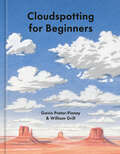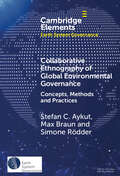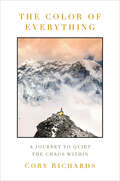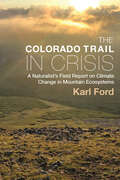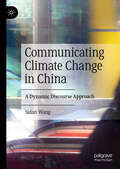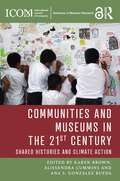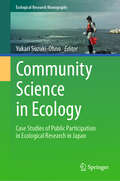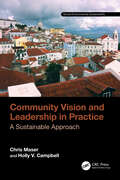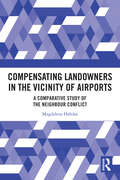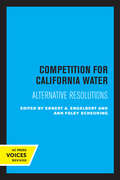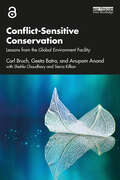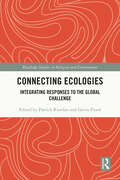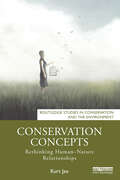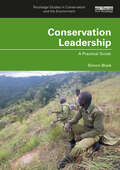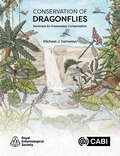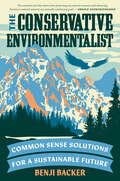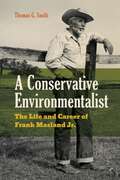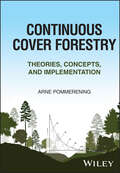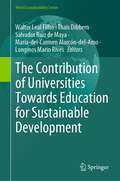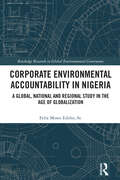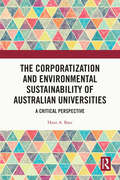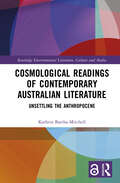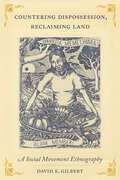- Table View
- List View
Climbing the Volcano: A Journey in Haiku
by Curtis ManleyThrough haiku, a young boy narrates his family&’s invigorating hike to the peak of Oregon&’s South Sister volcano.For centuries, haiku has offered meditation on the grace and majesty of nature. In Climbing the Volcano, old meets new as a young protagonist uses the poetic form to voice his wonder. Trekking uphill, the family encounters tiny toads, colorful butterflies, soaring birds of prey, and so much more to see, do, and feel. dormant volcano—but at sunrise each dayit blazesClimbing the Volcano is a call to adventure in the natural world, and a wonderful introduction to poetic forms. Young readers will be inspired to summit their own peaks and to find their own voices to share what they discover there. Whether you live in the shadow of a volcano, amid sprawling flatlands, or anywhere in between, Climbing the Volcano invites you to get out there and explore. Jennifer K. Mann&’s breezy, childlike artwork harmonizes with Curtis Manley&’s poetry to detail this mesmerizing Pacific Northwest journey.A Junior Library Guild Gold Standard Selection
Cloudspotting for Beginners
by Gavin Pretor-Pinney William GrillA beautifully illustrated guide to clouds and the sky for inspiring and educating curious minds with meteorological wonder.Renowned journalist, public speaker, and founder of the Cloud Appreciation Society Gavin Pretor-Pinney details the key facts and characteristics about each major cloud type. To accompany these scientific tidbits, William Grill&’s gorgeous illustrations of vast colorful skies and mesmerizing cloud patterns create a calming, thought-provoking learning experience.From low-lying Stratus to high-flying Cirrus, Cloudspotting for Beginners covers how clouds are formed, the altitudes they prefer, the curious shapes they take, how they affect other meterological events, and more. The book breaks down the life and structure of a cloud on a molecular level, and then even expands on their interesting cross-planetary variations—for example, Jupiter&’s clouds are composed of ammonia ice crystals and Saturn&’s clouds congregate in an inexplicable hexagon around the planet's North Pole.Clouds require a fascinating amount of chemical precision in order to exist, yet they disappear and form again on a daily basis with ease. Cloudspotting for Beginners is a whimsical lesson on the oft-overlooked extraordinary lives of clouds that will serve as a gentle reminder to be present and observant in the face of impermanence. Just as informative as it is poetic and peaceful, this is the perfect guide for cloud appreciators and sky lovers.
Collaborative Ethnography of Global Environmental Governance: Concepts, Methods and Practices (Elements in Earth System Governance)
by null Stefan C. Aykut null Simone Rödder null Max BraunEnvironmental mega conferences have become the format of choice in environmental governance. Conferences of the Parties (COPs) under the climate change and biodiversity conventions in particular attract global media attention and an ever-growing number of increasingly diverse actors, including scholars of global environmental politics. They are arenas for interstate negotiation, but also temporary interfaces that constitute and represent world society, and they focalise global struggles over just and sustainable futures. Collaborative event ethnography (CEE) as a research methodology emerged as a response to these developments. This volume retraces its genealogy, explains its conceptual and methodological foundations and presents insights into its practice. It is meant as an introduction for students, an overview for curious newcomers to the field, and an invitation for experienced researchers wishing to experiment with a new method. This title is also available as Open Access on Cambridge Core.
The Color of Everything: A Journey to Quiet the Chaos Within
by Cory RichardsA renowned climber and National Geographic photographer shares his incredible adventures—and the early trauma that drove him to seek such heights.&“An extraordinary memoir of mental illness that reads like a thriller.&”—Amy Ellis Nutt, Pulitzer Prize–winning journalist and author of Becoming Nicole&“In order to escape madness, I will live madly. I will risk my life in order to save it.&”Growing up in the mountains of Utah, Cory Richards was constantly surrounded by the outdoors. His father, a high school teacher and a ski patroller, spent years teaching Richards and his brother how to ski, climb, mountaineer, and survive in the wild. Despite a seemingly idyllic childhood, the Richards home was fraught with violence, grief, and mental illness. After being diagnosed with bipolar disorder and dropping out of high school, Richards subsumed himself in the worlds of photography and climbing, seeking out the farthest reaches of the world to escape the darkness. Then, in the midst of a wildly successful career in adventure photography, a catastrophic avalanche changed everything, forcing Richards to confront the trauma of his past, evaluate his own mental health, and learn to rewrite his story.The Color of Everything is a thrilling tale of risk and adventure, written by a man who has done it all: He&’s stood at the top of the world, climbed imposing mountain faces alone in the dark, and become the only American to summit an 8,000-meter peak in winter. But it is also the story of a tumultuous life—a stirring, lyrical memoir that captures the profound musings of an unquiet mind grappling with the meaning of success, the cost of fame and addiction, and whether it is possible to outrun your demons. With exquisite prose and disarming candor, accompanied by stunning photos from his career, Richards excavates the roots of his trauma and shares what it took for him to climb out of it.
The Colorado Trail in Crisis: A Naturalist’s Field Report on Climate Change in Mountain Ecosystems
by Karl FordThe Colorado Trail in Crisis addresses the sweeping transformation of western forests and wilderness ecosystems affected by climate change. This book is equal parts trail journal and synthesis of natural and human history. Karl Ford uses research on climate impacts to forests, wildlife, hydrology, and more to stress the urgent need for an action plan to reduce greenhouse gases and save forests and watersheds. Using his hike along the popular five-hundred-mile Colorado Trail to present his personal observations about more than a hundred miles of dead and dying forest, Karl Ford presents a brief environmental history of these areas of the state, weaving in scientific studies about forest mortality caused by insect infestations, wildfire, drought, and loss of snowpack, and describes the poor current prospects for reforestation as the climate continues to warm. His own Lakota ancestry, as well as historical references to local Tabeguache Ute Chief Ouray and displaced Ute populations, meaningfully frames important conversations about caretaking and connection to place. Ford also proposes potential solutions to drought and forest mortality problems, as well as varying approaches and limitations to mitigation efforts. The Colorado Trail in Crisis appeals to hikers and nature lovers seeking to learn about the natural history, beauty, and serenity of the Colorado Trail, as well as students, conservationists, and scientists researching climate change effects on Colorado mountain ecosystems.
Communicating Climate Change in China: A Dynamic Discourse Approach
by Sidan WangThis book explores how China's media narrate climate policy and climate change. With the rapid growth of economy and carbon emissions, China has been seen as having a key role in addressingclimate change and receives substantial attention from the media. In theChinese coverage, climate change issues can be interpreted as various concernsand ideas involving the dimensions of the economy, energy and emissions, publicinvolvement, science and ecology, and responsibility. In this sense, a discourseapproach can be used to understand how the newspapers construct the climatechange discourse and discourse networks in the coverage. This study selectsthree different newspapers in China, namely People’sDaily, China Daily and Southern Weekend. This book will interest scholars of Chinese politics, environmentalists, and media studies scholars.
Communities and Museums in the 21st Century: Shared Histories and Climate Action (ICOM Advances in Museum Research)
by Karen BrownCommunities and Museums in the 21st Century brings together innovative, multidisciplinary perspectives on contemporary museology and participatory museum practice that contribute to wider debates on museum communities, heritage, and sustainability. Set within the context of globalisation and decolonisation, this book draws upon bi-regional research that will enrich our understanding of the complex relationships between Europe, Latin America and the Caribbean through museum studies and practice. Chapters reflect upon the role of museums in defining community identities; the importance of young people’s participation and intergenerational work for sustainability; the role of museums in local development; and community-based museums and climate change. Contributors examine these issues through the lens of museum partnerships and practices, as well as testing the continued relevance of the notion of ‘integral museum’ and its relatives in the form of ecomuseums. With its focus on regional museums in Latin America and Caribbean, this book highlights how the case studies promote greater intercultural dialogue, global understanding and social cohesion. It also demonstrates how the methodology can be adapted to other communities who are facing the perils of climate change and unsustainable forms of development. Communities and Museums in the 21st Century proposes creative and sustainable strategies relevant to a globalised future. With its focus on global societal challenges, this book will appeal to museologists and museum practitioners, as well as those working in heritage studies, cultural studies, memory studies, art history, gender studies, and sustainable development.
Community Science in Ecology: Case Studies of Public Participation in Ecological Research in Japan (Ecological Research Monographs)
by Yukari Suzuki-OhnoThis book introduces community science (or citizen science) projects in Japan with a focus on ecology. Environments and ecosystems that have been slowly built up over time are changing and collapsing dramatically. In this rapidly changing environment, ecologists need to collaborate with volunteers in their research and activities to investigate and conserve a vast area. This book aims to guide ecologists in the practice of community science. The authors, who are leading ecologists and practitioners of community science projects, share their methods and lessons learned from practice. The book begins with the definition of community science and the following chapters introduce monitoring in ecological community science, using various methods such as observation, specimens, photographs, videos, sounds, and environmental DNA. Readers can learn about the advantages and disadvantages of these methods in ecological community science monitoring. The book also coverstopics such as scientific communication, data obtained from ecological community science monitoring, the rights of participants, decision-making in community science, and conservation activities with volunteers such as invasive alien species extermination and nature restoration. This book serves as a valuable resource for readers interested in ecological community science and its practice. The book is suitable for both undergraduate students and researchers as well as practitioners.
Community Vision and Leadership in Practice: A Sustainable Approach (Social-Environmental Sustainability)
by Chris Maser Holly V. CampbellThis book is about building and maintaining involved, sustainable, and inclusive communities from the ground up during a period of unprecedented growth and global change. It explains the concepts and principles of community and sustainability and provides students with a framework of sustainable community planning to put into practice. It is also designed to help communities everywhere identify and reconnect the true essence of their ecological setting with the objective of raising their quality of life by increasing social, environmental, and economic sustainability. Features: Provides up-to-date frameworks for sustainable community planning processes and case studies on community planning Explains tools for sustainable planning in accessible (non-specialist) language Illustrates a roadmap to an inclusive, collaborative future Explains aspects of sustainable community planning to maximize ecological ecosystem services and climate co-benefits simultaneously Includes discussion questions and suggestions following each chapter Intended for undergraduate and graduate students taking leadership and community courses with an emphasis on sustainable practices and ethics, as well as for citizens and professionals involved in community projects related to sustainability, the authors provide a forward-thinking approach, showing readers that they are capable of making a positive impact on the future of community development through sustainable approaches and ethical leadership practices.
Compensating Landowners in the Vicinity of Airports: A Comparative Study of the Neighbour Conflict
by Magdalena HabdasThe purpose of this book is to consider the neighbour conflict arising between airports and neighbouring owners of land, particularly with residential uses, as well as to assess the existing solutions applied to manage or resolve that conflict. The book explains why the neighbour conflict between the airport and landowners is of a particular kind and what legal instruments are applied to resolve it in an attempt to balance the interests of opposing parties. Readers will develop an understanding of how the law operates when damage is caused by a legal act of the government and what the limits of compensable loss are. In addition, the reader will discover the economic foundations of possible solutions and why not all market losses are legally compensable. Key features of this book include: • a consideration of key legal concepts such as neighbour law, nuisance, protection of property, land use restrictions, liability, and compensation to inform a unique analysis of neighbour law in the context of conflict between airports and neighbouring landowners • practical guidance on an airport’s legal liability towards neighbouring landowners • a comparative analysis of airport’s liability, compensation claims, their scope and economic effects • a comparative overview of planning and environmental solutions applied in a variety of jurisdictions • discussion of valuation methods and challenges when loss of property value is the measure of compensation The author’s intention is to promote conscious and civil relations among market participants, as opposed to opportunistic and speculative behaviour. This book is important reading for lawyers, academics, PhD students, and postgraduate students dealing with land use regulations, environmental law, compulsory purchase, eminent domain and expropriation issues and compensation for property restrictions, as well as with aviation law and legal aspects of airport operations.
Competition for California Water: Alternative Resolutions
by Ernest A. Engelbert Ann Foley ScheuringCalifornia’s water is at the center of an intense economic and political struggle. A balance between supply and demand must be reached, but it is far from certain that all Californians will get as much water as they want at a price they feel is right. Competition for California Water presents essential information on key issues, including: Costs: What would be the yields and what would be the costs, in dollars as well as less tangible values, of developing new sources of water? Cost-sharing: How much of the cost of water development and distribution should be borne by the general public, and how much by water users and other beneficiaries? Environmental protection: To what extent should environmental values be protected? Conservation: To what extent can the need for new water development be offset by conservation and more efficient use of water? Institutional reform: Can changes in the laws and institutions of California produce a more efficient system of water supply and management? Agriculture: How much increase in cost and/or loss of water can California agriculture bear and still remain competitive? Thirty-one experts on all aspects of this topic project alternative futures for California’s water supply. Written in nontechnical language, Competition for California Water is an invaluable source of information for Californians concerned with the future of their state.This title is part of UC Press's Voices Revived program, which commemorates University of California Press’s mission to seek out and cultivate the brightest minds and give them voice, reach, and impact. Drawing on a backlist dating to 1893, Voices Revived makes high-quality, peer-reviewed scholarship accessible once again using print-on-demand technology. This title was originally published in 1982.
Conflict-Sensitive Conservation: Lessons from the Global Environment Facility
by Carl Bruch Geeta Batra Anupam Anand Shehla Chowdhury Sierra KillianThis book provides an empirically formulated foundation for conflict-sensitive conservation, a field in which the existing literature relies primarily on anecdotal evidence. Seeking to better understand the impact of conflict on the implementation and outcomes of environmental projects, the Global Environment Facility (GEF) Independent Evaluation Office and the Environmental Law Institute undertook an evaluation of GEF support to fragile and conflict-affected contexts. Following a qualitative and quantitative analysis of documents from more than 4,000 projects, the research team discovered a statistically significant negative correlation between a country’s Fragile States Index score and the implementation quality of environmental projects in that country. In this book, the evaluation and research team explain these groundbreaking findings in detail, highlighting seven key case studies: Afghanistan, Albertine Rift, Balkans, Cambodia, Colombia, Lebanon, and Mali. Drawing upon additional research and interviews with GEF project implementation staff, the volume illustrates the pathways through which conflict and fragility frequently impact environmental projects. It also examines how practitioners and sponsoring institutions can plan and implement their projects to avoid or mitigate these issues and find opportunities to promote peacebuilding through their environmental interventions. Examining data from 164 countries and territories, this innovative book will be of great interest to students and scholars of environmental management, conservation, international development, and the fast-growing field of environmental peacebuilding. It will also be a great resource for practitioners working in these important fields.
Connecting Ecologies: Integrating Responses to the Global Challenge (Routledge Studies in Religion and Environment)
by Gavin Flood Patrick RiordanConnecting Ecologies focuses on the environmental aspects of Pope Francis’ encyclical Laudato Si’ and the challenge to care for our common home. It considers how best to devise and implement the new societal models needed to tackle the ecological problems facing the world today. The book addresses the need for and complexity of an integral ecology, one that looks not only at physical and biological processes but also allows for the contributions of theology, philosophy, spirituality, and psychology, including the implications for the human and social sciences. The contributions document four categories of resonances, resources, requirements, and responses evoked by a reading of Laudato Si’ and include consideration of other faith traditions. They reflect on how care for our common home motivates people in different places, cultures, and professions to cooperate for myriad goods in common. The volume is particularly relevant for scholars working in religious studies and theology with an interest in ecology, the environment, and the Anthropocene.
Conservation Concepts: Rethinking Human–Nature Relationships (Routledge Studies in Conservation and the Environment)
by Kurt JaxThis book provides a review of the multitude of conservation concepts, both from a scientific, philosophical, and social science perspective, asking how we want to shape our relationships with nature as humans, and providing guidance on which conservation approaches can help us to do this. Nature conservation is a contested terrain and there is not only one idea about what constitutes conservation but many different ones, which sometimes are conflicting. Employing a conceptual and historical analysis, this book sorts and interprets the differing conservation concepts, with a special emphasis on narrative analysis as a means for describing human–nature relationships and for linking conservation science to practice and to society at large. Case studies illustrate the philosophical issues and help to analyse major controversies in conservation biology. While the main focus is on Western ideas of conservation, the book also touches upon non-Western, including indigenous, concepts. The approach taken in this book emphasises the often implicit strategic and societal dimensions of conservation concepts, including power relations. In finding a path through the multitude of concepts, the book showcases that it is necessary to maintain the plurality of approaches, in order to successfully address different situations and societal choices. Overall, this book highlights the very tension which conservation biology must withstand between science and society: between what is possible and what we want individually or as a society or even more what is desirable. Bringing some order into this multitude will support more efficient conservation and conservation biology. This book will be of great interest to students and scholars studying nature conservation from a variety of disciplines, including biology, ecology, anthropology, sociology, geography, and philosophy. It will also be of use to professionals wanting to gain an understanding of the broad spectrum of conservation concepts and approaches and when to apply them.
Conservation Leadership: A Practical Guide (Routledge Studies in Conservation and the Environment)
by Simon BlackThis book is an important guide for individuals seeking to develop and grow their leadership skills in the wildlife conservation sector, across varied disciplines such as environmental management, conservation biology, and ecotourism.Conservation Leadership addresses what leadership is, why it is important, and how to be an effective leader. It identifies the common pitfalls or mistakes in a leader’s thinking or behaviour, and the unexpected consequences or responses which can arise, and then explores more helpful alternative approaches to leadership. The book is divided into three parts: Part I: Leadership principles Part II: Four areas of profound theory: knowledge, psychology, systems, and variation Part III: Skills and competencies for conservation leaders It focuses on contextual and organisational challenges in conservation, including limited resources, remote locations, fragile species of concern, politics, community conflict, crime, and commercial pressures. The scope is global, using diverse examples such as sea turtle head-starting in South Asia, reforestation in North Africa, bird conservation in North America, human–wildlife interactions in the Himalayas, and post-colonial issues in the Caribbean. Case studies illustrate key learning points from small local teams through to global transnational initiatives. Exercises in each chapter enable the exploration of less-familiar topics, including interpersonal skills, goal setting and performance measurement, plus a unique research-derived conservation leadership self-assessment tool.This book is an essential reading resource for professionals and senior leaders in the wildlife management and conservation sector, as well as students on biodiversity conservation, wildlife conservation, and environmental management courses.
Conservation of Dragonflies: Sentinels for Freshwater Conservation
by Dr Michael J SamwaysDragonflies are among the most familiar and popular of all insects, deeply embedded in human cultural history. They are iconic and tell us much about the environments in which we and they live. Their conservation is an important part of biodiversity conservation. One modern dragonfly species is listed as extinct, with many others currently threatened. It is now essential to increase conservation efforts towards saving these threatened species, with strategies now available for doing this. Recovery of dragonfly populations goes hand in hand with improvements to both freshwater conditions and bank vegetation quality. In contrast, some other dragonfly species have benefitted greatly from human transformation of the landscape, with artificial ponds in particular, increasing the population levels of many species. In turn, climate change is seeing many geographical range shifts. Dragonflies are variously sensitive to the health of freshwater systems, and the quality of vegetation along rivers and around ponds. Dragonflies are excellent indicators in these times of great concern over the quality of our freshwater supplies. Their wide range of sensitivities enables us to measure the extent to which freshwater ecosystems are either deteriorating or are improving when we undertake restoration. They enable us to gauge how well we are conserving freshwaters, whether ponds and lakes, streams or rivers. They are also good umbrellas for many other freshwater inhabitants, which altogether reflect the health of a freshwater system. Conservation of Dragonflies: Sentinels for Freshwater Conservation is for naturalists, citizen scientists, entomologists and conservation scientists, as well as practitioners and policy makers around the world.
The Conservative Environmentalist: Common Sense Solutions for a Sustainable Future
by Benji BackerA young, conservative environmentalist provides an intrepid vision for both solving our climate crisis and prioritizing the American national interest.Politicians, pseudo-experts, and other partisans have led us to believe that there are only two approaches to climate change: doomerism or denial. Benji Backer, Founder and Executive Chairman of the American Conservation Coalition, argues that both are dead ends. In The Conservative Environmentalist, he delivers an entirely new strategy to take care of the planet while putting put the economic interest of the American people first. Backer makes the compelling case that conservative principles are the key to climate solutions that actually work. In this book, you&’ll visit the country&’s most diverse ecosystems and consequential manufacturing hubs—from Utah coal mines and Texas oil fields to Louisiana wetlands and Rhode Island offshore wind farms—witnessing the power of individual entrepreneurship and local problem-solving. You&’ll be inspired by groundbreaking efforts to strengthen earth&’s ecosystems (that Green New Dealers and other Big Government advocates would prefer to keep hidden), like partnerships between oil and gas companies and environmental nonprofits to preserve thousands of acres of wetlands. Drawing on cutting-edge science, a deep understanding of local community needs, and his experience rallying politicians on both sides of the aisle to take action, Backer offers hope for everyone who cares about the state of the great outdoors. Fascinating, clear-headed, and full of surprises, The Conservative Environmentalist is the fresh, audacious approach needed to ensure a sustainable future, and particularly one that works for America.
A Conservative Environmentalist: The Life and Career of Frank Masland Jr.
by Thomas G. SmithA wealthy textile titan from Carlisle, Pennsylvania, Frank Masland Jr. was an ardent political conservative and an equally fervent conservationist who was well known and highly respected in the mid-twentieth-century environmental preservation community. This eye-opening biography charts Masland’s life work, telling the story of how he and fellow Republicans worked with Democrats to expand the national park system, preserve wild country, and protect the environment. Though a conservative conservationist appears to be a contradiction in terms today, this was not necessarily the case when Masland and his compatriots held sway. Conservatives, Masland insisted, had a duty to be good stewards of the earth for present and future generations, and they worked closely with members of both parties in Congress and nonpolitical conservation groups to produce landmark achievements. When conservatives turned against environmentalism during the Reagan presidency, Masland refused to join what historians have termed the “Republican reversal.” During his long life of nearly a hundred years, Masland used his voice, influence, experiences with nature, and considerable wealth to champion environmental causes at the national, state, and local levels. Engaging, informative, and at times eyebrow-raising, this portrait of a passionately anti-statist nature-loving Republican environmentalist documents the history of the twentieth-century conservation movement and reminds us of a time when conservative Republicans could work with liberal Democrats to protect the environment.
Container Gardening - The Permaculture Way: The Permaculture Way: Sustainably Grow Vegetables & More In Your Small Space
by Valéry TsimbaAnyone, anywhere can grow fresh, healthy produce, foster biodiversity, and reconnect with nature by using the permaculture approach—no matter your space or experience. Permaculture—rooted in centuries-old techniques for growing food with care for the Earth—is the key to producing a bigger harvest than you ever thought possible on your balcony, patio, driveway, deck, and anywhere in between! With sustainability as her guiding principle, Valéry Tsimba enthusiastically instructs home gardeners of all skill levels and backgrounds in her proven container gardening methods, from start to finish. Use the principles of permaculture to increase your garden’s productivity, biodiversity, and beauty by starting small and going slow. Get set up: Pick the best planters and tools for your space and learn how to adapt to natural conditions like wind and sun exposure. Increase your harvest naturally with companion planting, small-space composting, chemical-free fertilizers, and staggered harvests. Learn which plants are best suited to container gardens, from leafy greens and pollinator-friendly flowers to strawberries and even melons! Containers make gardening more accessible for everyone. Whether you live in an apartment, have a disability or chronic illness, have never gardened before, or are an experienced gardener new to permaculture, Container Gardening—The Permaculture Way brings sustainable gardening within reach.
Continuous Cover Forestry: Theories, Concepts, and Implementation
by Arne PommereningCONTINUOUS COVER FORESTRY Gain expertise in the development of healthier, more sustainable forests with this indispensable guide Continuous Cover Forestry (CCF) is an approach to forest management with over a century of history, one which applies ecological principles to the project of developing biologically diverse, structurally complex forests. Long used as the standard forest management method in Central Europe, CCF is generating renewed interest globally for its potential to develop and sustain forests that can withstand climate change impacts, maintain forest biodiversity in the face of major ecological challenges and offer better recreation experience. There is an increasingly urgent need for forest scientists and policymakers to be familiar with the toolkit provided by CCF. Continuous Cover Forestry: Theories, Concepts, and Implementation provides a thorough, up-to-date introduction to the theory and practice of CCF. Beginning with an overview of the method’s history and its foundational principles, the book provides detailed guidance for applying CCF methods to a range of ecological scenarios and forest types. The result is a clear, comprehensive portrait of this increasingly effective set of forestry tools. Continuous Cover Forestry readers will also find: Case studies throughout showing CCF at work in real-world forests Detailed discussion of topics such as forest structure, transformation, silvicultural systems, training, carbon forestry, conservation and more R code ready to take and apply Simple, adaptable models for deriving quantitative guidelines for CCF woodlands Continuous Cover Forestry is ideal for students, scholars and practitioners of forest science, forest ecology, conservation, and environmental management, as well as policymakers dealing with forestry or climate policy.
The Contribution of Universities Towards Education for Sustainable Development (World Sustainability Series)
by Walter Leal Filho Thais Dibbern Salvador Ruiz de Maya María-del-Carmen Alarcón-del-Amo Longinos Marin RivesThe book gathers inputs from universities and research organizations working on matters related to sustainable development in a variety of contexts. It also provides a platform for the dissemination of information on the latest initiatives, paving the way for technology transfer and networking. Furthermore, the book intends to provide a fertile basis upon which universities may cooperate more closely in this key area. Universities, as centers of education, research, and innovation, have a unique position and responsibility in promoting sustainability. They can offer degree programs, courses, and workshops focused on sustainability, environmental studies, and related fields, educating students and the wider community about the principles and challenges of sustainability. Also, universities can conduct cutting-edge research to address sustainability challenges, such as climate change, resource depletion, and biodiversity loss. They can develop innovative technologies and solutions that promote sustainable practices in various sectors, including energy, agriculture, transportation, and urban planning. There is a perceived need to better understand and engage universities further on sustainability initiatives. Against this backdrop and in order to facilitate a broad discussion on the contribution of universities toward sustainability, this book is being produced.Last but not least, a further aim of the book is to present methodological approaches and experiences deriving from case studies and projects, which aim to show how sustainability may be incorporated as part of university programs.
Corporate Environmental Accountability in Nigeria: A Global, National and Regional Study in the Age of Globalization (Routledge Research in Global Environmental Governance)
by Felix Moses EdohoThis book examines the imperative role of global environmental governance, and the need to incorporate corporate environmental accountability and mechanisms for enforcement, to effectively address the global environmental crisis.The author, Felix Moses Edoho, Sr., examines the issues at the various global, national, and regional levels. In Part I the book examines the issues at the global level and looks at the impact of transnational corporations (TNCs) and globalization on the global environmental crisis. Furthermore, it also examines the efforts of the United Nations in initiating global environmental architecture to tackle the crisis. Part II considers the issues at the national level and focuses on Nigeria. The author explores Nigeria’s regulatory and institutional framework for environmental governance and implementation. Lastly, at the regional level in Part III, the discourse centers on how decades of oil exploration and production have unleashed monumental ecological tragedies in the Niger Delta region of Nigeria due to the lack of corporate environmental accountability.This book will be of great interest to academics and students who are interested in broadening their knowledge of environmental governance and policy in developing countries. It will also be of value to environmental regulatory agencies and public administrators, development professionals, and TNCs.
The Corporatization and Environmental Sustainability of Australian Universities: A Critical Perspective
by Hans BaerAnalysing the juxtaposition of two trends in universities – corporatisation and environmental sustainability – this book explores how they are more contradictory than compatible. Hans A Baer argues that this contradiction is unavoidable because of the capitalist parameters in which they operate, including a commitment to on-going economic growth which contributes to social inequality, environmental degradation, and greenhouse gas emissions. Drawing on archival sources and Baer’s experiences in university sustainability forums, the book exposes how what universities claim to do in relation to environmental sustainability compares with their research, educational, operational and institutional activities. Presenting a critique of and a radical alternative to the status quo, this book is suitable for academics and students of anthropology, environmental studies and higher education.
Cosmological Readings of Contemporary Australian Literature: Unsettling the Anthropocene (Routledge Environmental Literature, Culture and Media)
by Kathrin Bartha-MitchellThis book presents an innovative and imaginative reading of contemporary Australian literature in the context of unprecedented ecological crisis. The Australian continent has seen significant, rapid changes to its cultures and land-use from the impact of British colonial rule, yet there is a rich history of Indigenous land-ethics and cosmological thought. By using the age-old idea of ‘cosmos’—the order of the world—to foreground ideas of a good order and chaos, reciprocity and more-than-human agency, this book interrogates the Anthropocene in Australia, focusing on notions of colonisation, farming, mining, bioethics, technology, environmental justice and sovereignty. It offers ‘cosmological readings’ of a diverse range of authors—Indigenous and non-Indigenous—as a challenge to the Anthropocene’s decline-narrative. As a result, it reactivates ‘cosmos’ as an ethical vision and a transculturally important counter-concept to the Anthropocene. Kathrin Bartha-Mitchell argues that the arts can help us envision radical cosmologies of being in and with the planet, and to address the very real social and environmental problems of our era. This book will be of particular interest to scholars and students of Ecocriticism, Environmental Humanities, and postcolonial, transcultural and Indigenous studies, with a primary focus on Australian, New Zealand, Oceanic and Pacific area studies.
Countering Dispossession, Reclaiming Land: A Social Movement Ethnography
by David E. GilbertTwo decades ago, a group of Indonesian agricultural workers began occupying the agribusiness plantation near their homes. In the years since, members of this remarkable movement have reclaimed collective control of their land and cultivated diverse agricultural forests on it, repairing the damage done over nearly a century of abuse. Countering Dispossession, Reclaiming Land is their story. David E. Gilbert offers an account of the ways these workers-turned-activists mobilized to move beyond industrial agriculture's exploitation of workers and the environment, illustrating how emancipatory and ecologically attuned ways of living with land are possible. At a time when capitalism has remade landscapes and reordered society, the Casiavera reclaiming movement stands as an inspiring example of what struggles for social and environmental justice can achieve.

